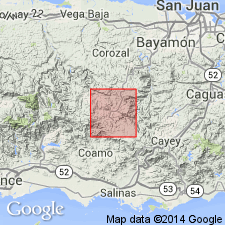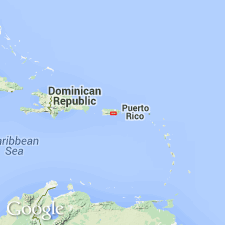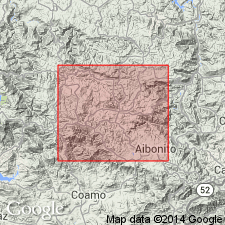
- Usage in publication:
-
- Botijas Limestone Member*
- Modifications:
-
- Named
- Dominant lithology:
-
- Limestone
- Conglomerate
- AAPG geologic province:
-
- Caribbean region
Summary:
The Botijas Limestone Member of the Coamo Formation, here named in the Barranquitas quadrangle, consists of massive fossiliferous, crystalline limestone and calcarenite with lenses of limestone conglomerate. Underlies the La (El) Reves Member of the Coamo. Thickness ranges from 25 to 140 m. Age is Late Cretaceous (Maastrichtian).
Source: GNU records (USGS DDS-6; Reston GNULEX).

- Usage in publication:
-
- Botijas Limestone Member*
- Modifications:
-
- Revised
- AAPG geologic province:
-
- Caribbean region
Summary:
Botijas Limestone Member is reassigned from the Coamo to the Pozas Formation because mapping in the Orocovis quad has shown that the Pozas in the Ciales quad is continuous with the so-called Coamo Formation in the Barranquitas quad; therefore the rocks are reassigned to the Pozas.
Source: GNU records (USGS DDS-6; Reston GNULEX).

- Usage in publication:
-
- Botijas Limestone Member*
- Modifications:
-
- Revised
- Age modified
- Biostratigraphic dating
- AAPG geologic province:
-
- Caribbean region
Summary:
Original mapping of Pozas Formation in Barranquitas quad, PR, may need to be revised because paleontological evidence suggests that three units, rather than two, are present, and that the Botijas Limestone Member is more likely Campanian than Maastrichtian. At localities 8-12 (roadcuts of PR Rte 772, on north valley wall of Rio Canabon, 1.85 km (airline) east-southeast of road intersection, Botijas, Barrio Canabon, Municipio de Barranquitas), limestone previously called Botijas Limestone Member by Briggs and Gelabert (1962), and considered by them to be continuous with Botijas elsewhere in the quad, is faunally different from Botijas Limestone Member. At section represented by localities 8-12, common presence of large specimens of TROCHACTAEON (T.) WOODSI in units 2-6 of the section is in distinct contrast to its total absence at localities 4-7 elsewhere in quad. Further fieldwork is needed to demonstrate whether these differences are stratigraphic or environmentally related. Age of Botijas Limestone Member is here changed from Maastrichtian to Campanian based on fossil evidence. Report contains correlation charts, measured sections, and fossil descriptions.
Source: GNU records (USGS DDS-6; Reston GNULEX).
For more information, please contact Nancy Stamm, Geologic Names Committee Secretary.
Asterisk (*) indicates published by U.S. Geological Survey authors.
"No current usage" (†) implies that a name has been abandoned or has fallen into disuse. Former usage and, if known, replacement name given in parentheses ( ).
Slash (/) indicates name conflicts with nomenclatural guidelines (CSN, 1933; ACSN, 1961, 1970; NACSN, 1983, 2005, 2021). May be explained within brackets ([ ]).

